

Restore Session. Lawrence Hall of Science - 24/7 Science.
Inglés. Astronomía. El cuerpo humano. Experimentos. Science Fair. Science Resources. (326) Pinterest. (326) Pinterest. (515) Pinterest. (515) Pinterest. (453) Pinterest. Fun Science Experiments for Kids - Cool Projects & Easy Ideas for Children. Ecosystems for Kids - Science Games and Videos. Ecosystems for Kids An ecosystem is a community of living and non-living things that function together.

Within an ecosystem, organisms are interdependent and adapted to the environment. Ecosystems can be as large as a desert or a sea or as small as a tree or a pond. Examples of ecosystems are coral reefs, rainforests, deep seas, deserts, tundra, savanna and urban centers like our cities. Play Quiz Games : NeoK12 is iPad & Android tablet ready. (414) Pinterest. CELLS alive! 6-8 Science. Physics Simulations Physics Simulation. Ciencias naturales-niños. Asociación Colombiana Pro Enseñanza de la Ciencia. Biology - PhET Simulations. The Best Edible Science Experiments You'll Actually Want to Eat.
Hands-on science experiments and projects are always a hit with kids, in the classroom and at home.
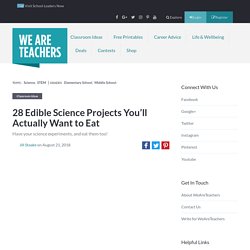
Want to make them even better? Make them delicious, too! There are plenty of food and kitchen science projects out there, but not all of them are exactly tasty. 4th Grade Science. Teaching - Science/Technology. The Physics Classroom. Science Lesson Plans - Scientific Method. Optics: Light, Color, and Their Uses Educator Guide. Product Type: Educator GuideAudience: Educators, Informal EducationGrade Levels: K-12Publication Year: 2000Product Number: EG-2000-10-64-MSFCSubjects: Physical Science The guide contains color and light activities using lenses, prisms and mirrors to create telescopes, periscopes, microscopes and kaleidoscopes.
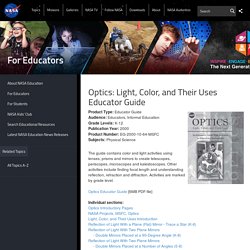
Other activities include finding focal length and understanding reflection, refraction and diffraction. Activities are marked by grade level. If You Teach Science, You Need Science Netlinks. Bio y Geo Bierzo. El equipo de profesores de Biología y Geología del Bierzo surge en mayo de 2013 como respuesta al deseo de coordinar e intercambiar nuestras experiencias docentes acumuladas a lo largo de los años.

Tras una primera reunión en el IES Europa de Ponferrada y algunas actividades iniciales, contactamos con el CFIE de Ponferrada y constituimos un grupo de trabajo para la elaboración de materiales prácticos. El desarrollo de esta actividad y la gran respuesta de los participantes nos llevó a ampliar la idea inicial, elaborando y recopilando una mayor variedad de materiales didácticos que hemos querido incluir en esta página web para la difusión bajo licencia libre entre el profesorado de Biología y Geología.
Sistema Solar. Science Fair Project Ideas, Answers, & Tools. EL PESO Y LA MASA. Easy Science Experiments, Videos, and Science Fair Ideas. Free Science Curriculum. Clearest Way to Teach Moon Phases...EVER! I originally found an idea similar to this online and I knew that I had to immediately make a run to the Dollar Tree and rummage through our science storeroom to collect the needed supplies to make this.
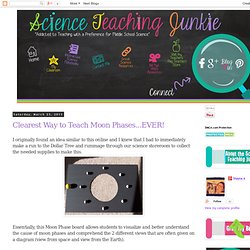
Essentially, this Moon Phase board allows students to visualize and better understand the cause of moon phases and comprehend the 2 different views that are often given on a diagram (view from space and view from the Earth). Up to this point, I've done a Lunar Lollipop Investigation, which I thought was great, but this beats it by a long shot! A large majority of my students don't really understand why the lit part of the moon doesn't face the sun on part of the view as seen from Earth on every moon phase diagram (see below). Even though I give many different examples and explanations, I still see a puzzled look on several of the students' faces. I really think this method will clear it up for even those puzzled kiddos. Followed by the waxing crescent. The first quarter. Then waxing gibbous. Science for Kids - Fun Experiments, Cool Facts, Online Games, Activities, Projects, Ideas, Technology.
Electric stuff to get all the sparks! Water Cycle in a Bag. Activity for ages 3 to 7.

I’m always on the lookout for simple, fun kids’ science activities so when I ran across this water cycle in a bag I couldn’t wait to give it a try. It was a quick prep activity that had a big payoff – my boys watched the water do its thing for days. I hope you love this water cycle in a bag too. P.S. Resources - Science and Technology. Here Is A Good Source of Interactive Games and Experiments for Science Teachers. The Lawrence Hall of Science is a great educational website from University of California, Berkeley.
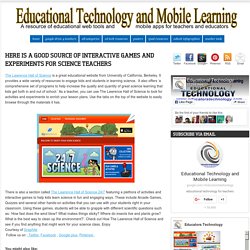
It provides a wide variety of resources to engage kids and students in learning science. It also offers ‘a comprehensive set of programs to help increase the quality and quantity of great science learning that kids get both in and out of school.’ Optics: Light, Color, and Their Uses Educator Guide. Una tabla periódica interactiva que muestra para qué se usan los diferentes elementos. Como ya sabréis, con frecuencia os hablamos acerca de diferentes proyectos relacionados con el mundo educativo.

En esta ocasión nos ha parecido realmente interesante destacar una tabla periódica interactiva que muestra para qué se usan los diferentes elementos químicos y nos explica las principales características de los mismos, lo que facilita enormemente el aprendizaje de la tabla. Tal y como podéis ver en la captura de pantalla que ilustra este artículo, únicamente es necesario acceder al enlace que os indicamos más adelante para consultar la tabla periódica en formato interactivo.
Su principal peculiaridad es que a medida que vamos pasando el cursor por encima de cada uno de los elementos la web nos muestra una representación gráfica de su uso y una breve explicación, por lo que su uso es realmente sencillo. Science Resources. Science Resources. ScienceNews for Students. Science Learning By Inquiry. Niños TryScience. Interactive Brain. Física Clásica. Física y Química. 25 herramientas TIC para el aula de Ciencias naturales. CIENCIAS06 imprimir docente. Pregúntale a un Astrónomo, Para Niños. Educating Scientists: 6 Science Websites for Kids and Teens. Curiosity is an innate feature on which learning is based, and which, unfortunately, loses intensity and passion in many people as they become adults.
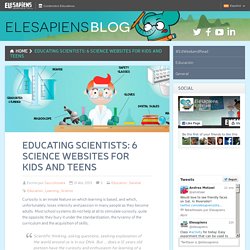
Most school systems do not help at all to stimulate curiosity, quite the opposite: they bury it under the standardization, the tyranny of the curriculum and the acquisition of skills. Scientific thinking, asking questions, seeking explanation of the world around us is in our DNA. But ... does a 12 years old preteen have the curiosity and enthusiasm for learning of a 5 years old child? Fortunately, thanks to technology, today the acquisition of knowledge is not limited to school. Science Lessons & Projects: Electricity & Magnetism. Search form Search Subject: Physics/Electricity & Magnetism Aluminum-Air Battery Construct a simple battery that can power a light.
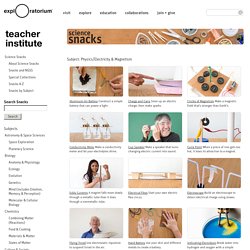
Charge and Carry Store up an electric charge, then make sparks. Circles of Magnetism. Guide to Space. By Matt Williams on April 24, 2008 The Solar System: Outer Space: Space Exploration: People: Abd Al-Rahman Al-SufiAbu Ishaq Ibrahim al-ZarqaliAlbert EinsteinAristotleAryabhataAvenpace (Ibn Bajja)Avicenna (Ibn-Sina)Charles MessierChristiaan HuygensDemocritusEdmond HalleyEdwin “Buzz” AldrinEdwin HubbleFamous AstronautsFrancis BaconGalileo GalileeGerard KuiperGiovanni Domenico CassiniJan OortJohannes KeplerJohannes Gottfried GalleJohn Couch AdamsLord Kelvin (William Thomson)Muhammad ibn Musa al-KhwarizmiNicolaus CopernicusNilakantha SomayajiPtolemyQutb al-Din al-ShiraziRené DescartesRobert BoyleRobert HookeSir Isaac NewtonStephen HawkingNeil ArmstrongTycho BraheUrbain Le VerrierYuri GagarinValentina TereshvokaWilliam Bond CouchWilliam HerschelWilliam Lassell. 10 Best Channels for STEM Education on YouTube.
Was Formula 1 in your syllabus growing up? Probably not, but times are changing. As of this year, Formula 1 cars have made the grade, and will be appearing in public school curriculum. NASCAR’s Acceleration Nation puts your child in the driver’s seat with an inspirational dose of STEM education. Los Planetas del Sistema Solar Su Trayectoria, Datos y Caracteristicas.
Inicio » Temas Científicos » Los Planetas del Sistema Solar Su Trayectoria, Datos y Caracteristicas. Kids Corner. Electricity for kids - and everyone else: A simple introduction! Advertisement by Chris Woodford. Last updated: April 14, 2016. If you've ever sat watching a thunderstorm, with mighty lightning bolts darting down from the sky, you'll have some idea of the power of electricity. A bolt of lightning is a sudden, massive surge of electricity between the sky and the ground beneath. The energy in a single lightning bolt is enough to light 100 powerful lamps for a whole day or to make a couple of hundred thousand slices of toast! Electricity is the most versatile energy source that we have; it is also one of the newest: homes and businesses have been using it for not much more than a hundred years. What is electricity? Electricity is a type of energy that can build up in one place or flow from one place to another.
Static electricity Static electricity often happens when you rub things together. Here Comes the Sun: Crash Course Kids #5.1. A Brief History of Global Warming. Global Warming - A video by NASA. Bill Nye - How Stuff Works - Solar Energy. How Solar Panel Works. How a photovoltaic cell works. How Solar Panels Work in a Nutshell. 15 Fun Science Activities for Kids. The Science Corner(1) The Sourcebook for Teaching Science. The Sourcebook for Teaching Science – Strategies, Activities, and Instructional Resources, provides new and experienced teachers a wealth of teaching strategies, resources, lessons, activities, and ideas to enhance the teaching and learning of physics, chemistry, biology, and the earth and space sciences.
Resources are based on learning theory, and are designed to stimulate student interest and involvement. As students engage in the activities of this book, they develop higher order reasoning skills, and a deeper understanding of scientific concepts and their relevance to their everyday life. FISICA PARA TODOS: 03 CINEMÁTICA.